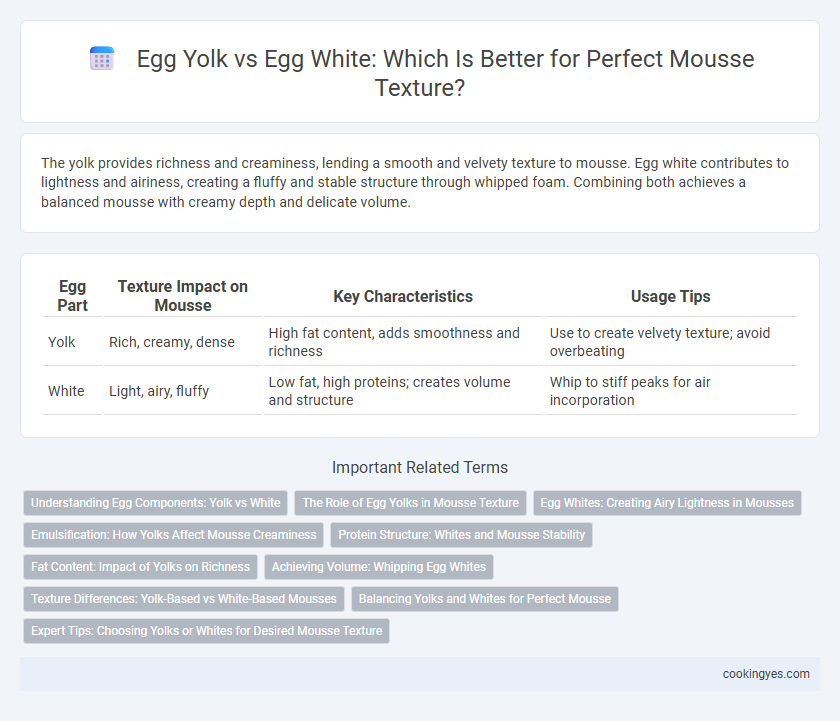The yolk provides richness and creaminess, lending a smooth and velvety texture to mousse. Egg white contributes to lightness and airiness, creating a fluffy and stable structure through whipped foam. Combining both achieves a balanced mousse with creamy depth and delicate volume.
Table of Comparison
| Egg Part | Texture Impact on Mousse | Key Characteristics | Usage Tips |
|---|---|---|---|
| Yolk | Rich, creamy, dense | High fat content, adds smoothness and richness | Use to create velvety texture; avoid overbeating |
| White | Light, airy, fluffy | Low fat, high proteins; creates volume and structure | Whip to stiff peaks for air incorporation |
Understanding Egg Components: Yolk vs White
Egg yolks contain fats and emulsifiers like lecithin that provide richness and creaminess, essential for smooth, dense mousse texture. Egg whites consist mainly of water and proteins that, when whipped, create a stable foam, adding lightness and airiness to the mousse. Balancing yolk and white components controls mousse consistency, with yolks delivering silkiness and whites contributing volume and lift.
The Role of Egg Yolks in Mousse Texture
Egg yolks play a crucial role in mousse texture by contributing richness, creaminess, and stability due to their high fat and lecithin content. The emulsifying properties of egg yolks help bind air and fat, resulting in a smooth, velvety mousse with a firm yet delicate structure. In contrast, egg whites provide lightness and volume but lack the fat necessary for the mousse's creamy mouthfeel.
Egg Whites: Creating Airy Lightness in Mousses
Egg whites play a crucial role in mousse texture by trapping air through whisking, creating a stable foam that imparts lightness and volume. The proteins in egg whites coagulate upon whipping, forming a network that holds air bubbles, resulting in a fluffy, airy structure essential for smooth mousses. Unlike yolks, egg whites contribute minimal fat, allowing for a delicate, ethereal consistency prized in traditional mousse recipes.
Emulsification: How Yolks Affect Mousse Creaminess
Egg yolks play a crucial role in mousse texture by providing lecithin, a natural emulsifier that enhances creaminess and stability. The emulsification properties of yolks help bind fat and water molecules, resulting in a smoother and more velvety mousse. Egg whites, while essential for aeration, lack emulsifying compounds, making yolks indispensable for rich and creamy mousse consistency.
Protein Structure: Whites and Mousse Stability
Egg whites contain albumin proteins that denature and form a stable foam when beaten, providing the necessary structure and air incorporation for a light mousse texture. Egg yolks consist primarily of lipoproteins and emulsifiers, which interfere with foam stability and can cause the mousse to collapse or become dense. For optimal mousse stability and volume, the protein structure in egg whites is essential, as it traps air and maintains a consistent, airy texture.
Fat Content: Impact of Yolks on Richness
Egg yolks contain significantly higher fat content, approximately 5 grams per yolk, which contributes to a richer and creamier mousse texture compared to egg whites that are virtually fat-free. The fat in yolks emulsifies and adds smoothness, creating a denser and more luxurious mouthfeel in mousse preparations. In contrast, egg whites primarily provide structure and volume but lack the richness imparted by yolk fats.
Achieving Volume: Whipping Egg Whites
Whipping egg whites is essential for achieving volume in mousse, as the proteins create a stable foam that traps air and provides lightness to the texture. In contrast, yolks contribute richness and emulsification but do not provide the same airy lift necessary for a fluffy mousse. Properly whipped whites result in a smooth, airy mousse structure, making them critical for volume and texture optimization.
Texture Differences: Yolk-Based vs White-Based Mousses
Yolk-based mousses deliver a rich, creamy texture due to the fat content in egg yolks, which adds smoothness and a velvety mouthfeel. White-based mousses rely on whipped egg whites, creating a light, airy, and fluffy texture with more volume and a delicate structure. The choice between yolk and white affects the mousse's density and stability, with yolk-based mousses being denser and white-based mousses offering a more ethereal consistency.
Balancing Yolks and Whites for Perfect Mousse
Balancing egg yolks and whites is essential for achieving the ideal mousse texture, with yolks providing richness and softness while whites contribute lightness and volume. Using more yolks results in a denser, creamier mousse, whereas increasing whites creates a fluffier, airier consistency. Precise ratio adjustments ensure the perfect combination of smoothness and lift, crucial for a stable and delicate mousse structure.
Expert Tips: Choosing Yolks or Whites for Desired Mousse Texture
Yolks provide richness and a creamy, dense texture to mousse, enhancing flavor depth with their fat content and emulsifying properties. Whites contribute lightness and airiness, creating a fluffy, delicate mousse structure through their ability to trap air when whipped. For a balanced mousse, expert chefs often combine yolks for body and whites for volume, adjusting ratios based on desired texture and richness.
Yolk vs White for mousse texture Infographic

 cookingyes.com
cookingyes.com